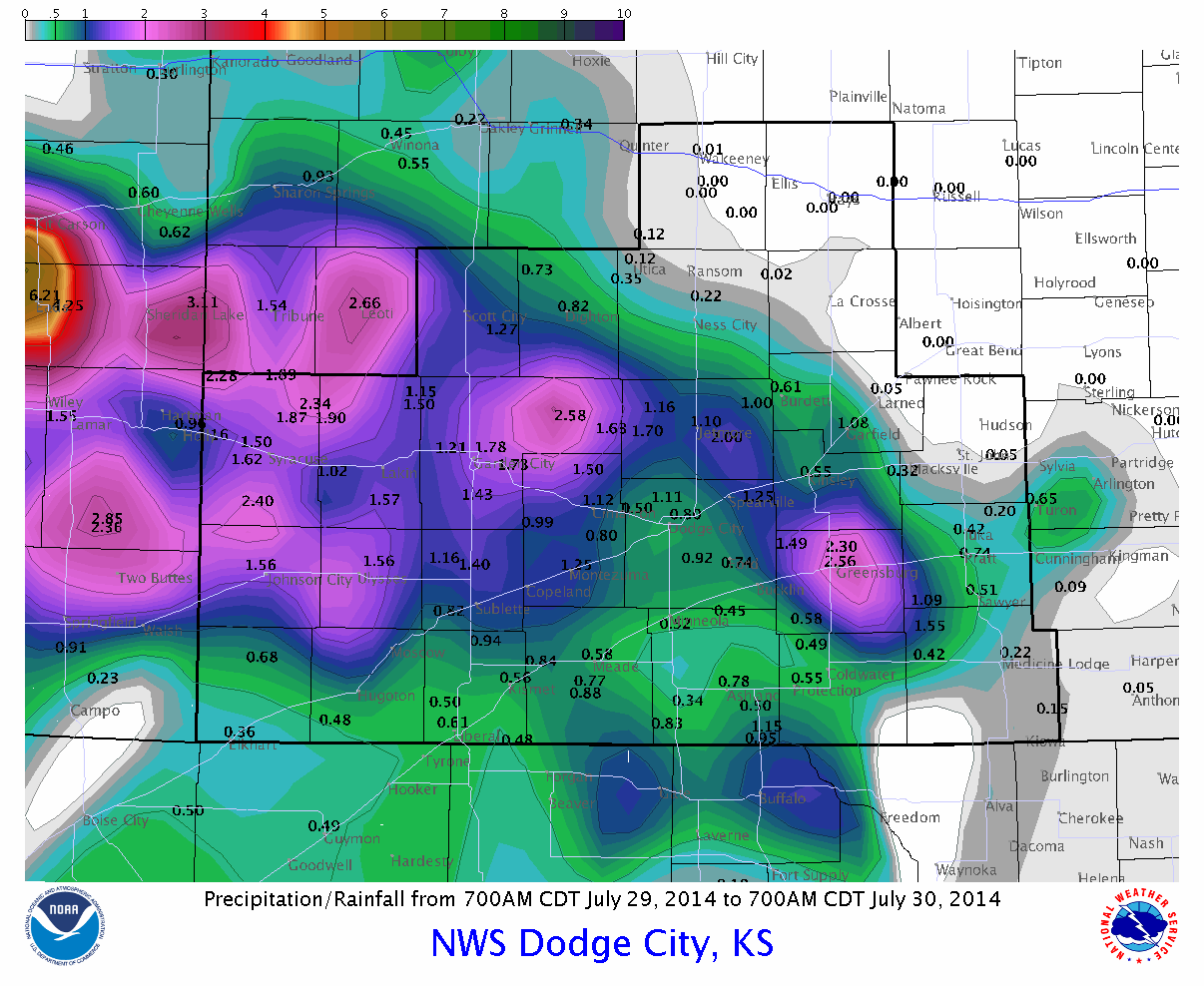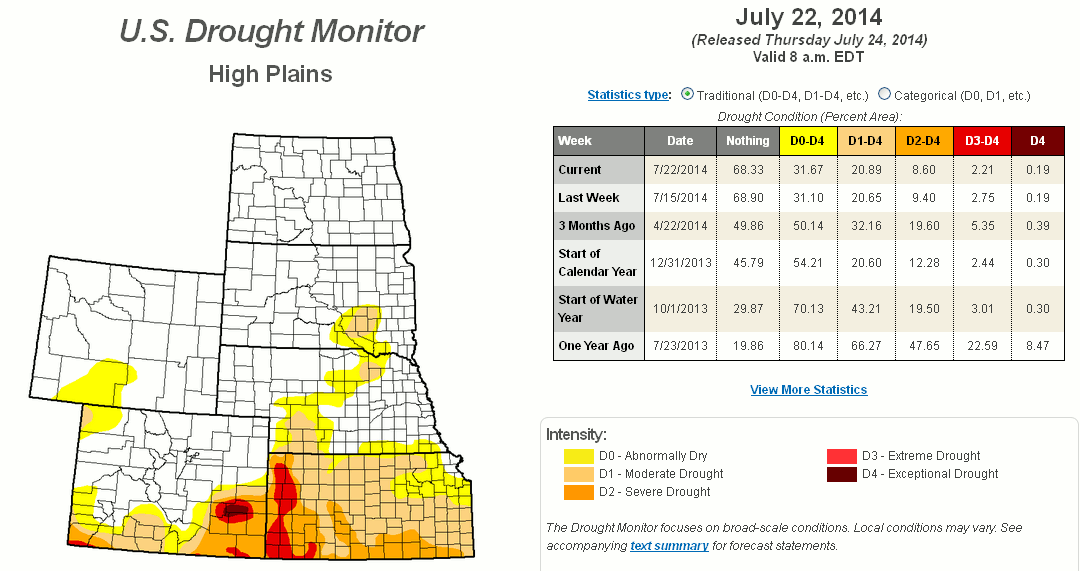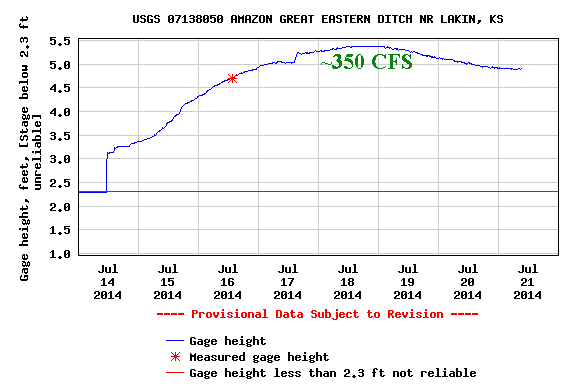As discussed in the
June 26th update, the atmosphere finally gave up the fight to summer. The flow aloft
had significantly decreased across North America and the
North American Monsoon has commenced. There has already been heavy rains across parts of the Rockies of New Mexico and Colorado. In fact, a very heavy rainfall event occurred across the eastern plains of Colorado over the weekend resulting in flash flooding in the Rocky Ford, La Junta and Lamar areas and adjacent areas of southeast Colorado. The Arkansas River responded with high flow headed towards the Kansas/Colorado border. There might even be enough flow to eventually make it to Garden City and perhaps even farther east! The graph that follows shows the increasing flow (cubic feet per second) along the Arkansas River near Granada as of Monday afternoon (July 14).

Now if you read carefully above you might have caught that I said the flow aloft HAD significantly decreased. But as of this writing the jet stream has strengthened and dipped WAY south into the upper midwest. It is definitely an anomalously strong dip south and anomalously strong jet stream for mid July. This dip is sending a significantly strong cold front south into Kansas and eventually into Texas. Unfortunately it was too strong to help bring widespread thunderstorms to the high plains although scattered storms did develop as they moved into Oklahoma.
The following map shows the position of the jet stream and upper flow and other features...
A notable feature on this image (from Monday afternoon) was the low over northern Idaho. This system should drop southeast as it rounds the corner from the anomalously strong system over the upper midwest.
The result should be rather widespread rain and thunderstorms from late Tuesday into early Thursday. In addition, temperatures across the corn belt and much of Kansas will be much colder than average for the remainder of the week (14th - 19th). There may be some records set, especially given the fact that highs across the eastern 2/3 of Kansas may struggle to get out of the 60s on Wednesday! As for rainfall, the Weather Prediction Center is fairly confident with the rainfall. The following map depicts expected precipitation through Sunday night July 20th. Not everyone will get this much precipitation, while others will get even more than that! This is just an expected average. This is great news from parts of Texas and Oklahoma where it has been getting increasingly dry again...

The convective season (considered to be the warm season months) has brought a lot of rain to much of Kansas but sadly there are still areas that have missed out (by chance). The following map shows an estimate of rainfall since April 14, 2014...
One area south of Mulliville, KS in Kiowa county has had a little over 20 inches during this period! WOW! A large part of the region has had much above normal amounts during this 90 day period, while other locations across the far southeast parts of Colorado and southwest Kansas have received much, much less.
Even with the much above normal rainfall for late May and June, there is still a huge deficit of precipitation over a longer period. At Dodge City at the airport, precipitation was above normal for the period October 1, 2013 through July 13, 2014 (considered part of the 2014 Water Year).
But going back to October 1, 2010 the deficit is pretty clear...
It's much the same across the entire high plains area. So, it is not surprising that much of the region is still technically in a drought.
Outlook look for the remainder of the summer.
The NA Monsoon mentioned above should continue into early August and will be robust at times. I'm confident that southern and central Rockies will have above to much above normal rainfall into August. The adjacent plains should also see above normal rainfall. There is still a question on how far east this will get into Kansas. Even though it will be getting hot again across Kansas (and with a smattering of 100's) next week, there will still be additional cold fronts enhancing the opportunity for convective events into August. With moderate confidence, rainfall for all of July should be normal to above (again there will be unlucky ones with below normal liquid). The average temperature for July should end up below normal across much of the high plains. Will we reach 100 in Dodge City this year? Probably, but not many times. I'm going for 3 so we'll see.
Later in August I'm not seeing a huge change. There will still be a few fronts but I'm not seeing the blast furnace type of weather that we sometimes get. Overall for August, I'm looking for near normal temperatures and near normal rainfall, if not above. More on August at a later time...
Finally, what about El Nino?
The Southern Oscillation Index (SOI) is a measure to where we can see the progress of a developing El Nino or La Nina. To have an El Nino, the numbers should be significantly negative for an extended stretch (like 3 months). That green line above should be negative.
If you read back through earlier posts I had mentioned several times that there was a question about the strength of El Nino, or if it might even develop! Much of the media and national weather enthusiasts have been predicting a "super" El Nino. I just don't see that happening and I'm really starting to wonder if one will develop at all! Regardless, other forcing mechanisms across the globe are calling the shots for our current weather regime. What I'm saying is we don't need an El Nino (ENSO only partly influences our weather across Kansas anyway) to get beneficial weather.
I'll try another update in about a week. I might even give a hint to some early thinking for the late fall and winter too. It's still early but I'm starting to have a hunch.



























